The Impact of Leadership, LMX on Employees' Psychological Capital
VerifiedAdded on 2023/05/30
|12
|3285
|196
Essay
AI Summary
This essay provides a literature review of the concept of leadership and its relationship with employee performance and psychological capital. It discusses the shift from earlier leadership theories to more contemporary approaches like transformational leadership, authentic leadership, and leader-member exchange (LMX). The paper highlights the significance of leadership in motivating employees, enhancing job satisfaction, and reducing work stress, referencing the application of LMX theory within ABC Advertisement Private Limited. It further explores the construct of psychological capital and its impact on employee performance, emphasizing the importance of positive leadership in fostering a positive environment. The essay also provides recommendations for improving employee performance and identifies a gap in the literature regarding the long-term impact of leadership styles on psychological capital.
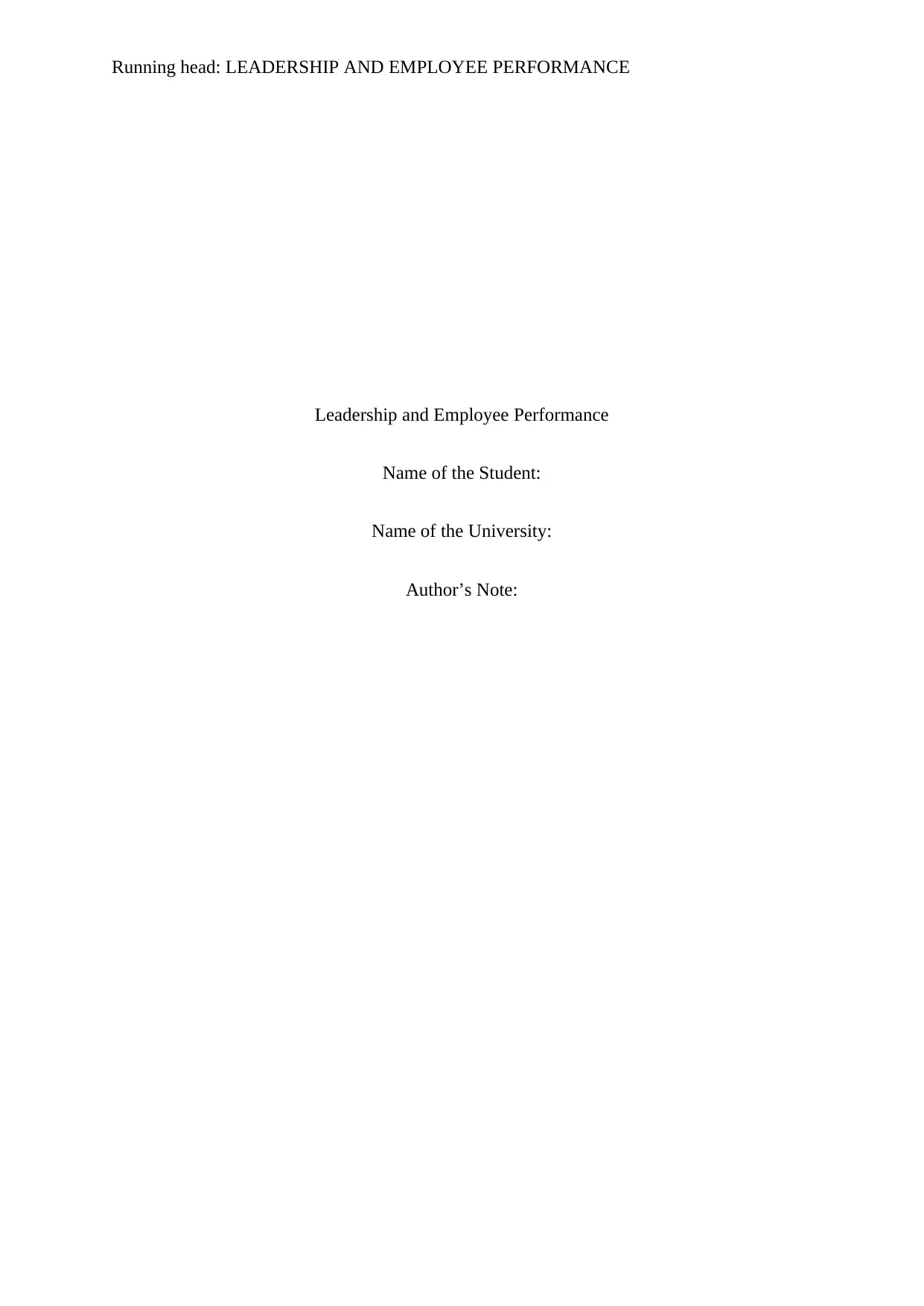
Running head: LEADERSHIP AND EMPLOYEE PERFORMANCE
Leadership and Employee Performance
Name of the Student:
Name of the University:
Author’s Note:
Leadership and Employee Performance
Name of the Student:
Name of the University:
Author’s Note:
Paraphrase This Document
Need a fresh take? Get an instant paraphrase of this document with our AI Paraphraser
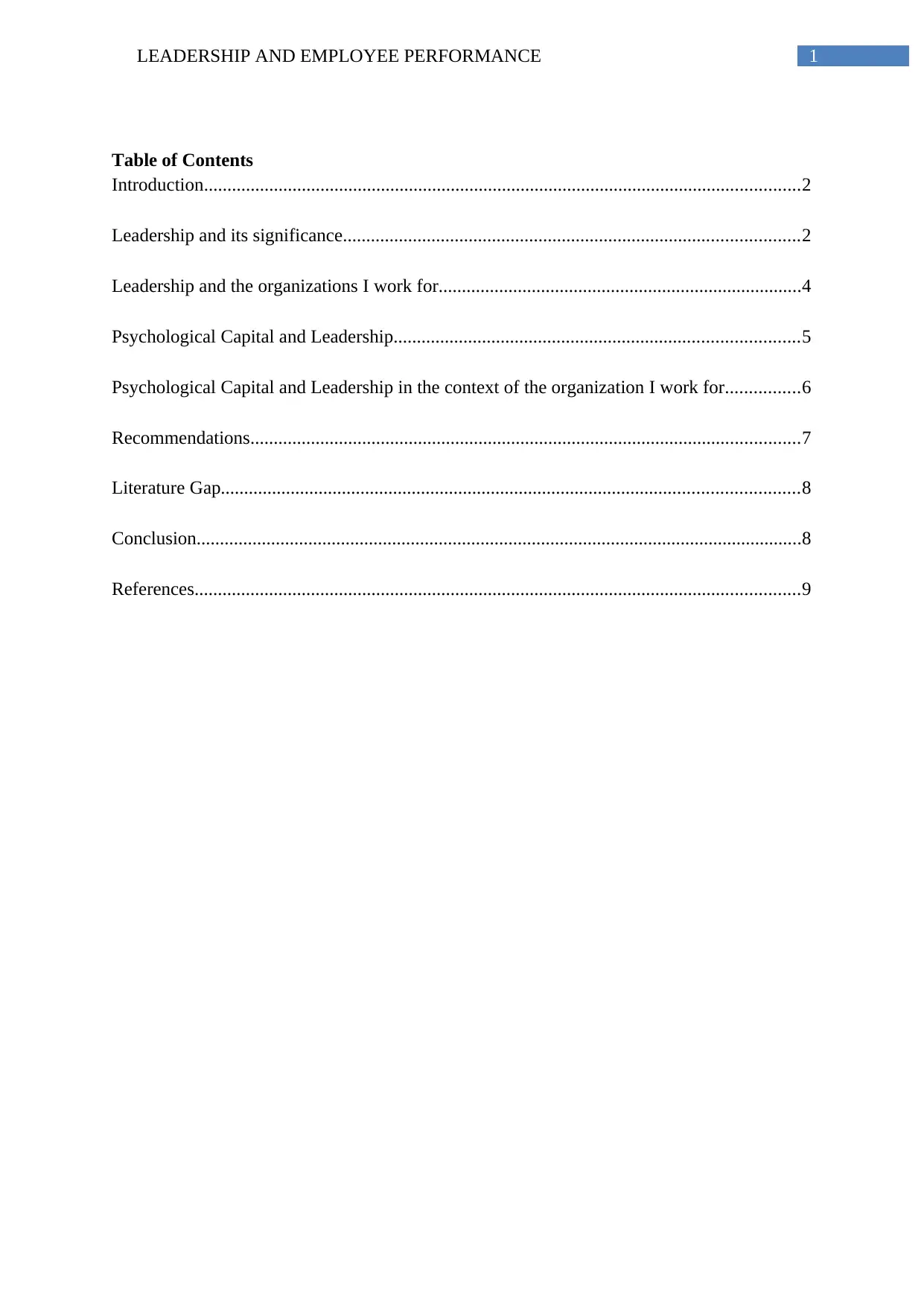
1LEADERSHIP AND EMPLOYEE PERFORMANCE
Table of Contents
Introduction................................................................................................................................2
Leadership and its significance..................................................................................................2
Leadership and the organizations I work for..............................................................................4
Psychological Capital and Leadership.......................................................................................5
Psychological Capital and Leadership in the context of the organization I work for................6
Recommendations......................................................................................................................7
Literature Gap............................................................................................................................8
Conclusion..................................................................................................................................8
References..................................................................................................................................9
Table of Contents
Introduction................................................................................................................................2
Leadership and its significance..................................................................................................2
Leadership and the organizations I work for..............................................................................4
Psychological Capital and Leadership.......................................................................................5
Psychological Capital and Leadership in the context of the organization I work for................6
Recommendations......................................................................................................................7
Literature Gap............................................................................................................................8
Conclusion..................................................................................................................................8
References..................................................................................................................................9
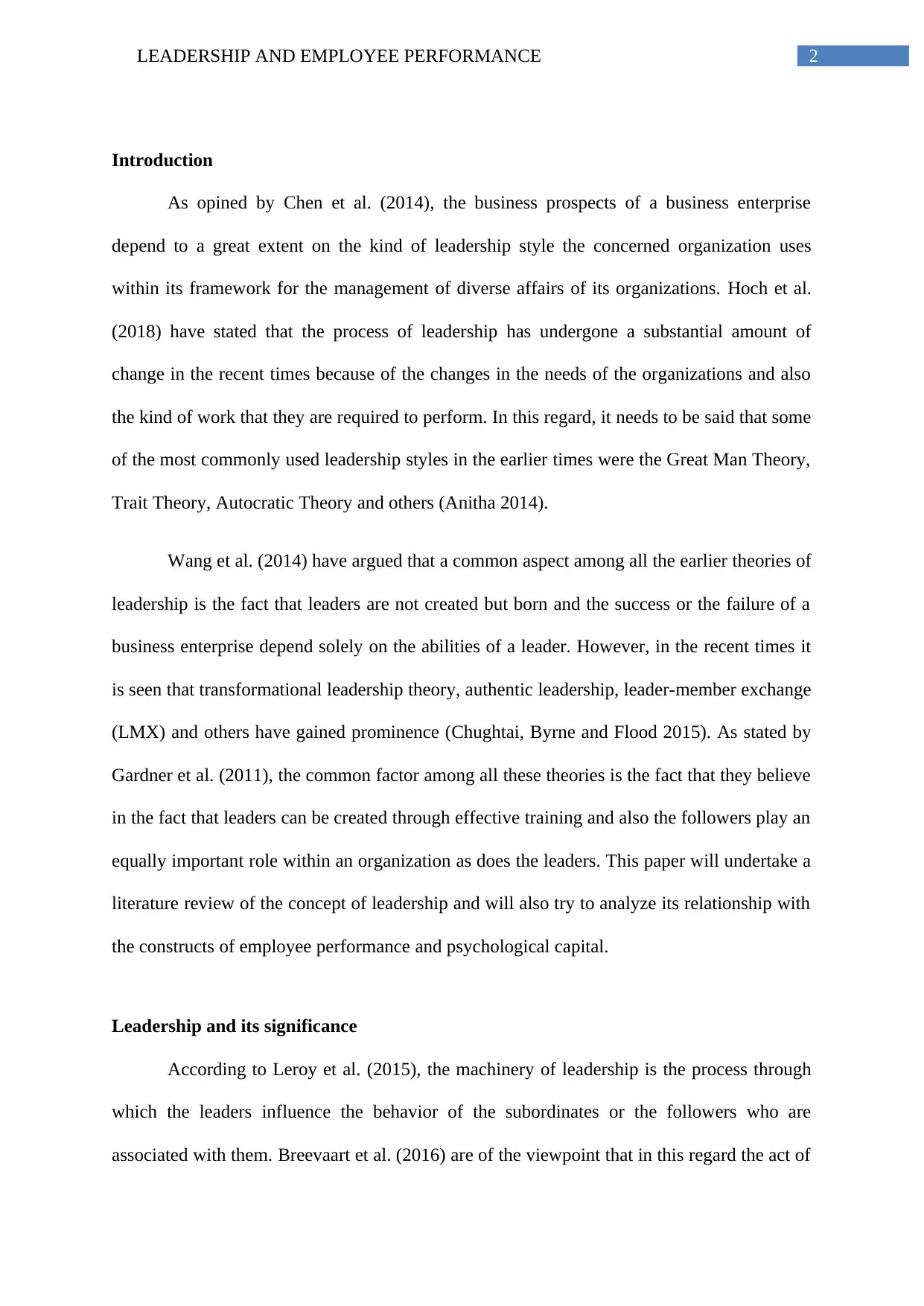
2LEADERSHIP AND EMPLOYEE PERFORMANCE
Introduction
As opined by Chen et al. (2014), the business prospects of a business enterprise
depend to a great extent on the kind of leadership style the concerned organization uses
within its framework for the management of diverse affairs of its organizations. Hoch et al.
(2018) have stated that the process of leadership has undergone a substantial amount of
change in the recent times because of the changes in the needs of the organizations and also
the kind of work that they are required to perform. In this regard, it needs to be said that some
of the most commonly used leadership styles in the earlier times were the Great Man Theory,
Trait Theory, Autocratic Theory and others (Anitha 2014).
Wang et al. (2014) have argued that a common aspect among all the earlier theories of
leadership is the fact that leaders are not created but born and the success or the failure of a
business enterprise depend solely on the abilities of a leader. However, in the recent times it
is seen that transformational leadership theory, authentic leadership, leader-member exchange
(LMX) and others have gained prominence (Chughtai, Byrne and Flood 2015). As stated by
Gardner et al. (2011), the common factor among all these theories is the fact that they believe
in the fact that leaders can be created through effective training and also the followers play an
equally important role within an organization as does the leaders. This paper will undertake a
literature review of the concept of leadership and will also try to analyze its relationship with
the constructs of employee performance and psychological capital.
Leadership and its significance
According to Leroy et al. (2015), the machinery of leadership is the process through
which the leaders influence the behavior of the subordinates or the followers who are
associated with them. Breevaart et al. (2016) are of the viewpoint that in this regard the act of
Introduction
As opined by Chen et al. (2014), the business prospects of a business enterprise
depend to a great extent on the kind of leadership style the concerned organization uses
within its framework for the management of diverse affairs of its organizations. Hoch et al.
(2018) have stated that the process of leadership has undergone a substantial amount of
change in the recent times because of the changes in the needs of the organizations and also
the kind of work that they are required to perform. In this regard, it needs to be said that some
of the most commonly used leadership styles in the earlier times were the Great Man Theory,
Trait Theory, Autocratic Theory and others (Anitha 2014).
Wang et al. (2014) have argued that a common aspect among all the earlier theories of
leadership is the fact that leaders are not created but born and the success or the failure of a
business enterprise depend solely on the abilities of a leader. However, in the recent times it
is seen that transformational leadership theory, authentic leadership, leader-member exchange
(LMX) and others have gained prominence (Chughtai, Byrne and Flood 2015). As stated by
Gardner et al. (2011), the common factor among all these theories is the fact that they believe
in the fact that leaders can be created through effective training and also the followers play an
equally important role within an organization as does the leaders. This paper will undertake a
literature review of the concept of leadership and will also try to analyze its relationship with
the constructs of employee performance and psychological capital.
Leadership and its significance
According to Leroy et al. (2015), the machinery of leadership is the process through
which the leaders influence the behavior of the subordinates or the followers who are
associated with them. Breevaart et al. (2016) are of the viewpoint that in this regard the act of
⊘ This is a preview!⊘
Do you want full access?
Subscribe today to unlock all pages.

Trusted by 1+ million students worldwide
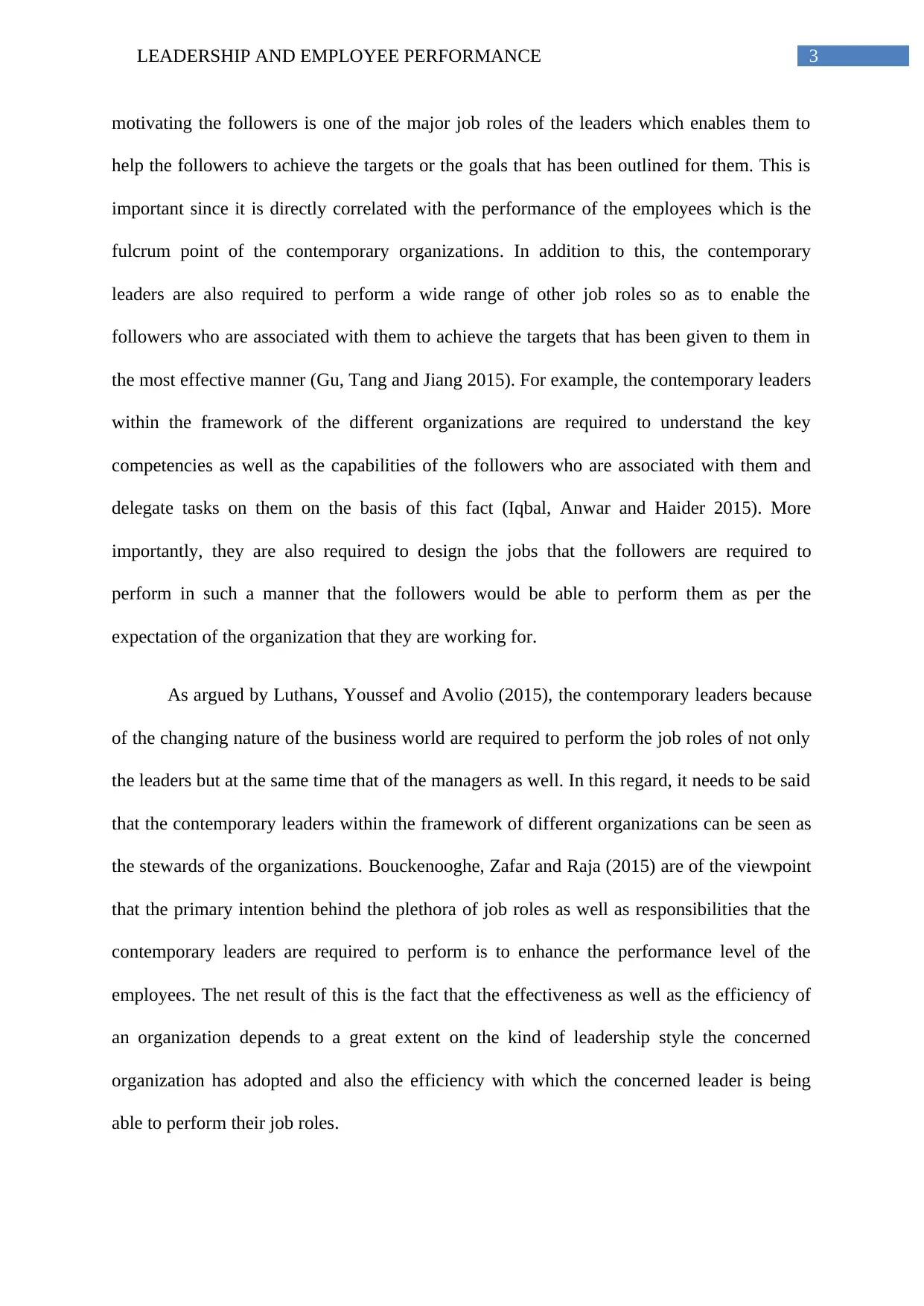
3LEADERSHIP AND EMPLOYEE PERFORMANCE
motivating the followers is one of the major job roles of the leaders which enables them to
help the followers to achieve the targets or the goals that has been outlined for them. This is
important since it is directly correlated with the performance of the employees which is the
fulcrum point of the contemporary organizations. In addition to this, the contemporary
leaders are also required to perform a wide range of other job roles so as to enable the
followers who are associated with them to achieve the targets that has been given to them in
the most effective manner (Gu, Tang and Jiang 2015). For example, the contemporary leaders
within the framework of the different organizations are required to understand the key
competencies as well as the capabilities of the followers who are associated with them and
delegate tasks on them on the basis of this fact (Iqbal, Anwar and Haider 2015). More
importantly, they are also required to design the jobs that the followers are required to
perform in such a manner that the followers would be able to perform them as per the
expectation of the organization that they are working for.
As argued by Luthans, Youssef and Avolio (2015), the contemporary leaders because
of the changing nature of the business world are required to perform the job roles of not only
the leaders but at the same time that of the managers as well. In this regard, it needs to be said
that the contemporary leaders within the framework of different organizations can be seen as
the stewards of the organizations. Bouckenooghe, Zafar and Raja (2015) are of the viewpoint
that the primary intention behind the plethora of job roles as well as responsibilities that the
contemporary leaders are required to perform is to enhance the performance level of the
employees. The net result of this is the fact that the effectiveness as well as the efficiency of
an organization depends to a great extent on the kind of leadership style the concerned
organization has adopted and also the efficiency with which the concerned leader is being
able to perform their job roles.
motivating the followers is one of the major job roles of the leaders which enables them to
help the followers to achieve the targets or the goals that has been outlined for them. This is
important since it is directly correlated with the performance of the employees which is the
fulcrum point of the contemporary organizations. In addition to this, the contemporary
leaders are also required to perform a wide range of other job roles so as to enable the
followers who are associated with them to achieve the targets that has been given to them in
the most effective manner (Gu, Tang and Jiang 2015). For example, the contemporary leaders
within the framework of the different organizations are required to understand the key
competencies as well as the capabilities of the followers who are associated with them and
delegate tasks on them on the basis of this fact (Iqbal, Anwar and Haider 2015). More
importantly, they are also required to design the jobs that the followers are required to
perform in such a manner that the followers would be able to perform them as per the
expectation of the organization that they are working for.
As argued by Luthans, Youssef and Avolio (2015), the contemporary leaders because
of the changing nature of the business world are required to perform the job roles of not only
the leaders but at the same time that of the managers as well. In this regard, it needs to be said
that the contemporary leaders within the framework of different organizations can be seen as
the stewards of the organizations. Bouckenooghe, Zafar and Raja (2015) are of the viewpoint
that the primary intention behind the plethora of job roles as well as responsibilities that the
contemporary leaders are required to perform is to enhance the performance level of the
employees. The net result of this is the fact that the effectiveness as well as the efficiency of
an organization depends to a great extent on the kind of leadership style the concerned
organization has adopted and also the efficiency with which the concerned leader is being
able to perform their job roles.
Paraphrase This Document
Need a fresh take? Get an instant paraphrase of this document with our AI Paraphraser

4LEADERSHIP AND EMPLOYEE PERFORMANCE
Baron, Franklin and Hmieleski (2016) have stated that the prominence that the notion
of positive leadership has gained within the spectrum of the contemporary business world is
being reflected in the plethora of theories related to leadership that has gained prominence in
the recent times. One of the most important theories in this regard is the authentic theory of
leader through the use of which the positive leaders are required to use the notions of ethics
as well as morality within the job roles that they perform in an organization (Paterson,
Luthans and Jeung 2014). In addition to this, the leaders using this style of leadership are also
required to establish ethical relationships with the different followers who are associated with
them. Another important theory of leadership which has gained a substantial degree of
importance within the cannon of contemporary business world is the leader-member
exchange (LMX) theory. It is pertinent to note that for the effective use of this theory the
leaders are required to use the perspective of the followers who are associated with them for
the important decisions that they make (Newman et al. 2014).
Chen et al. (2014) are of the viewpoint that this is important since the followers who
are associated with the leaders, since the traditional times have been relegated to the
background and this style of leadership offer equal amount of prominence to the followers as
well. This is important since it not only offers a certain amount of say to the followers in the
important matters of the organization but at the same time enhances their job satisfaction
level as well. As opined by Wang et al. (2014), a high level of job satisfaction not only
increases the performance level of the employees, their well-being, the amount of work stress
that they feel but at the same time reduces the attrition rate of the organization as well.
Leadership and the organizations I work for
I work for the organization ABC Advertisement Private Limited which belongs to the
entertainment industry and offer advertisement related services to the organizations. The
Baron, Franklin and Hmieleski (2016) have stated that the prominence that the notion
of positive leadership has gained within the spectrum of the contemporary business world is
being reflected in the plethora of theories related to leadership that has gained prominence in
the recent times. One of the most important theories in this regard is the authentic theory of
leader through the use of which the positive leaders are required to use the notions of ethics
as well as morality within the job roles that they perform in an organization (Paterson,
Luthans and Jeung 2014). In addition to this, the leaders using this style of leadership are also
required to establish ethical relationships with the different followers who are associated with
them. Another important theory of leadership which has gained a substantial degree of
importance within the cannon of contemporary business world is the leader-member
exchange (LMX) theory. It is pertinent to note that for the effective use of this theory the
leaders are required to use the perspective of the followers who are associated with them for
the important decisions that they make (Newman et al. 2014).
Chen et al. (2014) are of the viewpoint that this is important since the followers who
are associated with the leaders, since the traditional times have been relegated to the
background and this style of leadership offer equal amount of prominence to the followers as
well. This is important since it not only offers a certain amount of say to the followers in the
important matters of the organization but at the same time enhances their job satisfaction
level as well. As opined by Wang et al. (2014), a high level of job satisfaction not only
increases the performance level of the employees, their well-being, the amount of work stress
that they feel but at the same time reduces the attrition rate of the organization as well.
Leadership and the organizations I work for
I work for the organization ABC Advertisement Private Limited which belongs to the
entertainment industry and offer advertisement related services to the organizations. The
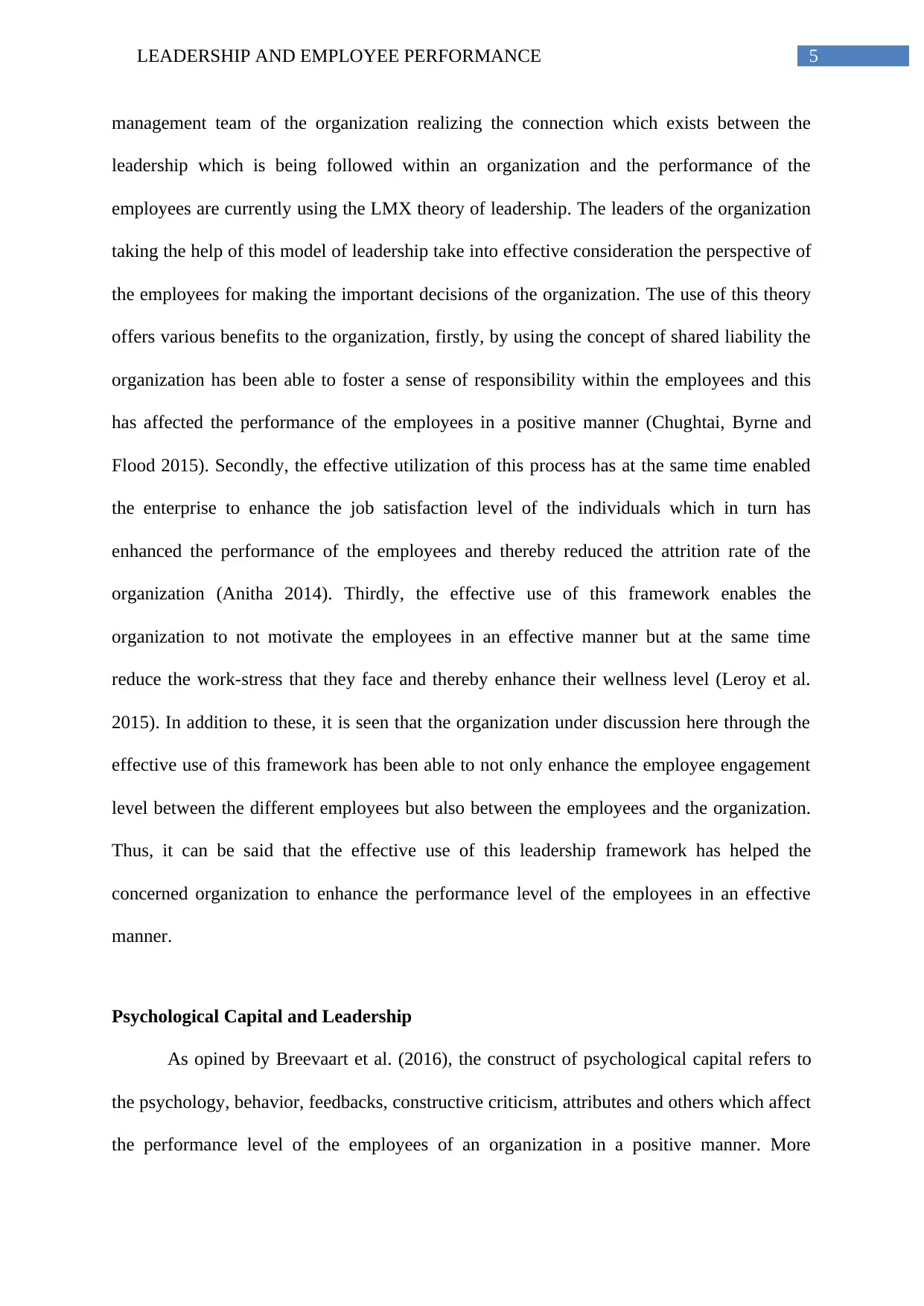
5LEADERSHIP AND EMPLOYEE PERFORMANCE
management team of the organization realizing the connection which exists between the
leadership which is being followed within an organization and the performance of the
employees are currently using the LMX theory of leadership. The leaders of the organization
taking the help of this model of leadership take into effective consideration the perspective of
the employees for making the important decisions of the organization. The use of this theory
offers various benefits to the organization, firstly, by using the concept of shared liability the
organization has been able to foster a sense of responsibility within the employees and this
has affected the performance of the employees in a positive manner (Chughtai, Byrne and
Flood 2015). Secondly, the effective utilization of this process has at the same time enabled
the enterprise to enhance the job satisfaction level of the individuals which in turn has
enhanced the performance of the employees and thereby reduced the attrition rate of the
organization (Anitha 2014). Thirdly, the effective use of this framework enables the
organization to not motivate the employees in an effective manner but at the same time
reduce the work-stress that they face and thereby enhance their wellness level (Leroy et al.
2015). In addition to these, it is seen that the organization under discussion here through the
effective use of this framework has been able to not only enhance the employee engagement
level between the different employees but also between the employees and the organization.
Thus, it can be said that the effective use of this leadership framework has helped the
concerned organization to enhance the performance level of the employees in an effective
manner.
Psychological Capital and Leadership
As opined by Breevaart et al. (2016), the construct of psychological capital refers to
the psychology, behavior, feedbacks, constructive criticism, attributes and others which affect
the performance level of the employees of an organization in a positive manner. More
management team of the organization realizing the connection which exists between the
leadership which is being followed within an organization and the performance of the
employees are currently using the LMX theory of leadership. The leaders of the organization
taking the help of this model of leadership take into effective consideration the perspective of
the employees for making the important decisions of the organization. The use of this theory
offers various benefits to the organization, firstly, by using the concept of shared liability the
organization has been able to foster a sense of responsibility within the employees and this
has affected the performance of the employees in a positive manner (Chughtai, Byrne and
Flood 2015). Secondly, the effective utilization of this process has at the same time enabled
the enterprise to enhance the job satisfaction level of the individuals which in turn has
enhanced the performance of the employees and thereby reduced the attrition rate of the
organization (Anitha 2014). Thirdly, the effective use of this framework enables the
organization to not motivate the employees in an effective manner but at the same time
reduce the work-stress that they face and thereby enhance their wellness level (Leroy et al.
2015). In addition to these, it is seen that the organization under discussion here through the
effective use of this framework has been able to not only enhance the employee engagement
level between the different employees but also between the employees and the organization.
Thus, it can be said that the effective use of this leadership framework has helped the
concerned organization to enhance the performance level of the employees in an effective
manner.
Psychological Capital and Leadership
As opined by Breevaart et al. (2016), the construct of psychological capital refers to
the psychology, behavior, feedbacks, constructive criticism, attributes and others which affect
the performance level of the employees of an organization in a positive manner. More
⊘ This is a preview!⊘
Do you want full access?
Subscribe today to unlock all pages.

Trusted by 1+ million students worldwide
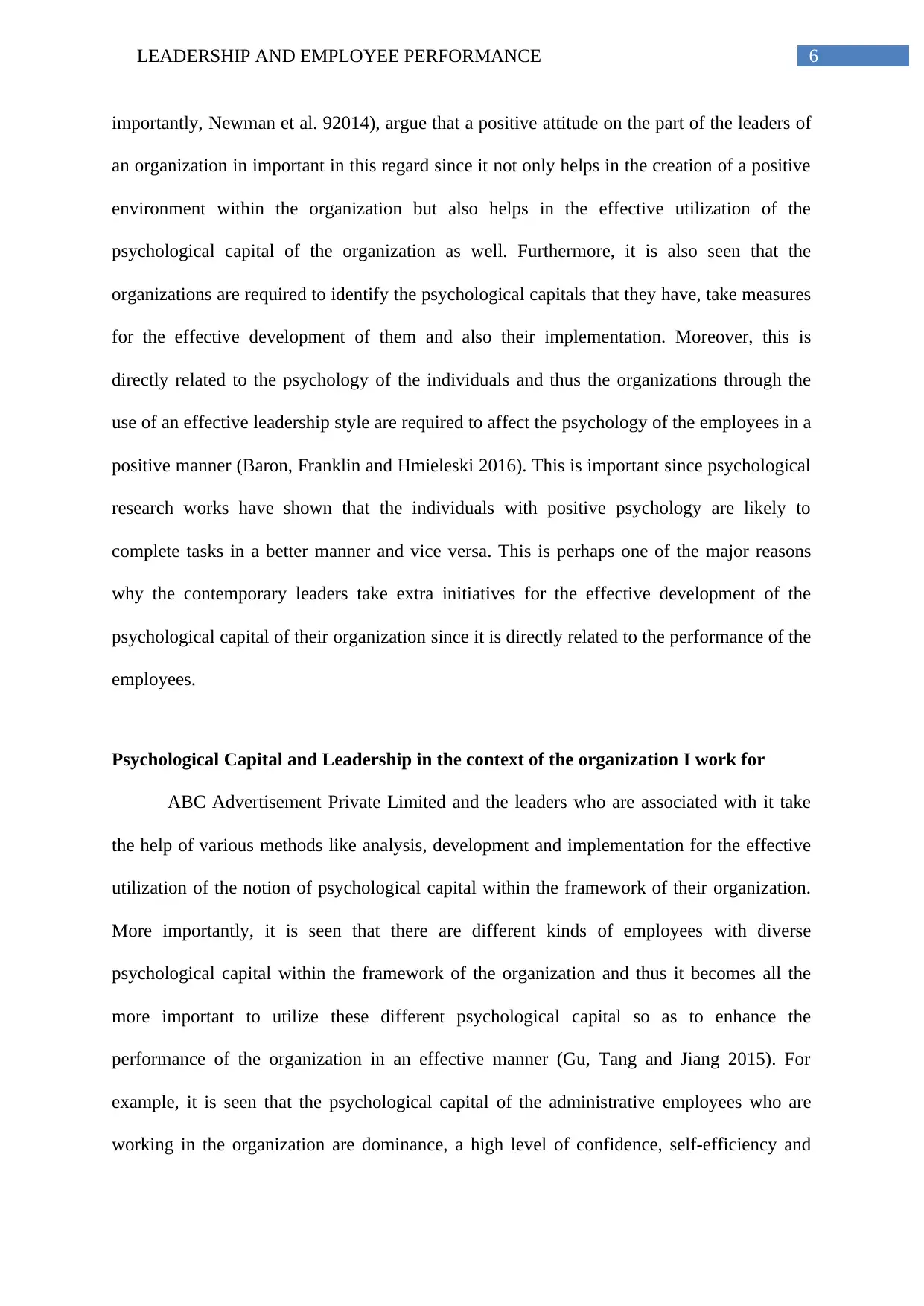
6LEADERSHIP AND EMPLOYEE PERFORMANCE
importantly, Newman et al. 92014), argue that a positive attitude on the part of the leaders of
an organization in important in this regard since it not only helps in the creation of a positive
environment within the organization but also helps in the effective utilization of the
psychological capital of the organization as well. Furthermore, it is also seen that the
organizations are required to identify the psychological capitals that they have, take measures
for the effective development of them and also their implementation. Moreover, this is
directly related to the psychology of the individuals and thus the organizations through the
use of an effective leadership style are required to affect the psychology of the employees in a
positive manner (Baron, Franklin and Hmieleski 2016). This is important since psychological
research works have shown that the individuals with positive psychology are likely to
complete tasks in a better manner and vice versa. This is perhaps one of the major reasons
why the contemporary leaders take extra initiatives for the effective development of the
psychological capital of their organization since it is directly related to the performance of the
employees.
Psychological Capital and Leadership in the context of the organization I work for
ABC Advertisement Private Limited and the leaders who are associated with it take
the help of various methods like analysis, development and implementation for the effective
utilization of the notion of psychological capital within the framework of their organization.
More importantly, it is seen that there are different kinds of employees with diverse
psychological capital within the framework of the organization and thus it becomes all the
more important to utilize these different psychological capital so as to enhance the
performance of the organization in an effective manner (Gu, Tang and Jiang 2015). For
example, it is seen that the psychological capital of the administrative employees who are
working in the organization are dominance, a high level of confidence, self-efficiency and
importantly, Newman et al. 92014), argue that a positive attitude on the part of the leaders of
an organization in important in this regard since it not only helps in the creation of a positive
environment within the organization but also helps in the effective utilization of the
psychological capital of the organization as well. Furthermore, it is also seen that the
organizations are required to identify the psychological capitals that they have, take measures
for the effective development of them and also their implementation. Moreover, this is
directly related to the psychology of the individuals and thus the organizations through the
use of an effective leadership style are required to affect the psychology of the employees in a
positive manner (Baron, Franklin and Hmieleski 2016). This is important since psychological
research works have shown that the individuals with positive psychology are likely to
complete tasks in a better manner and vice versa. This is perhaps one of the major reasons
why the contemporary leaders take extra initiatives for the effective development of the
psychological capital of their organization since it is directly related to the performance of the
employees.
Psychological Capital and Leadership in the context of the organization I work for
ABC Advertisement Private Limited and the leaders who are associated with it take
the help of various methods like analysis, development and implementation for the effective
utilization of the notion of psychological capital within the framework of their organization.
More importantly, it is seen that there are different kinds of employees with diverse
psychological capital within the framework of the organization and thus it becomes all the
more important to utilize these different psychological capital so as to enhance the
performance of the organization in an effective manner (Gu, Tang and Jiang 2015). For
example, it is seen that the psychological capital of the administrative employees who are
working in the organization are dominance, a high level of confidence, self-efficiency and
Paraphrase This Document
Need a fresh take? Get an instant paraphrase of this document with our AI Paraphraser
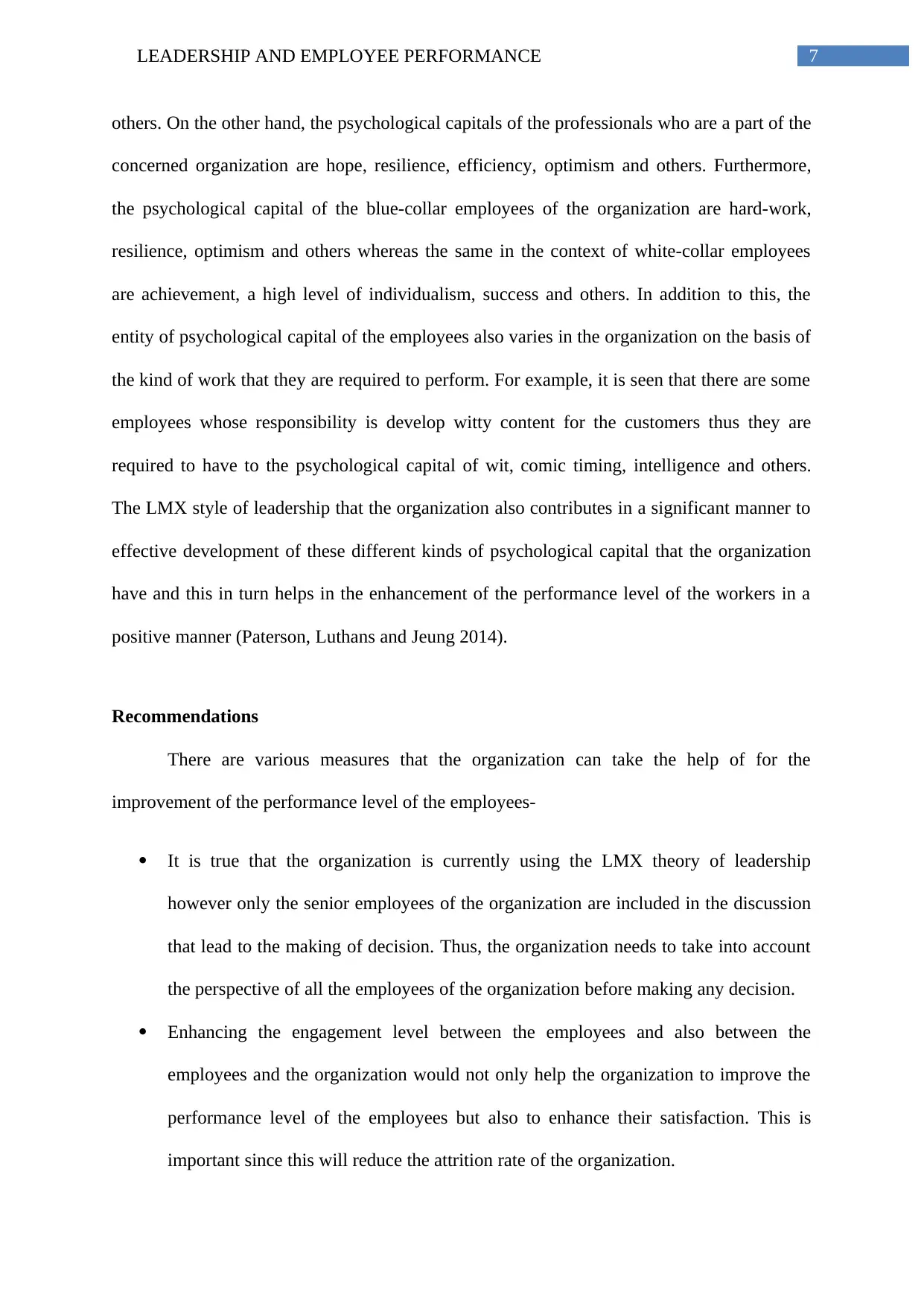
7LEADERSHIP AND EMPLOYEE PERFORMANCE
others. On the other hand, the psychological capitals of the professionals who are a part of the
concerned organization are hope, resilience, efficiency, optimism and others. Furthermore,
the psychological capital of the blue-collar employees of the organization are hard-work,
resilience, optimism and others whereas the same in the context of white-collar employees
are achievement, a high level of individualism, success and others. In addition to this, the
entity of psychological capital of the employees also varies in the organization on the basis of
the kind of work that they are required to perform. For example, it is seen that there are some
employees whose responsibility is develop witty content for the customers thus they are
required to have to the psychological capital of wit, comic timing, intelligence and others.
The LMX style of leadership that the organization also contributes in a significant manner to
effective development of these different kinds of psychological capital that the organization
have and this in turn helps in the enhancement of the performance level of the workers in a
positive manner (Paterson, Luthans and Jeung 2014).
Recommendations
There are various measures that the organization can take the help of for the
improvement of the performance level of the employees-
It is true that the organization is currently using the LMX theory of leadership
however only the senior employees of the organization are included in the discussion
that lead to the making of decision. Thus, the organization needs to take into account
the perspective of all the employees of the organization before making any decision.
Enhancing the engagement level between the employees and also between the
employees and the organization would not only help the organization to improve the
performance level of the employees but also to enhance their satisfaction. This is
important since this will reduce the attrition rate of the organization.
others. On the other hand, the psychological capitals of the professionals who are a part of the
concerned organization are hope, resilience, efficiency, optimism and others. Furthermore,
the psychological capital of the blue-collar employees of the organization are hard-work,
resilience, optimism and others whereas the same in the context of white-collar employees
are achievement, a high level of individualism, success and others. In addition to this, the
entity of psychological capital of the employees also varies in the organization on the basis of
the kind of work that they are required to perform. For example, it is seen that there are some
employees whose responsibility is develop witty content for the customers thus they are
required to have to the psychological capital of wit, comic timing, intelligence and others.
The LMX style of leadership that the organization also contributes in a significant manner to
effective development of these different kinds of psychological capital that the organization
have and this in turn helps in the enhancement of the performance level of the workers in a
positive manner (Paterson, Luthans and Jeung 2014).
Recommendations
There are various measures that the organization can take the help of for the
improvement of the performance level of the employees-
It is true that the organization is currently using the LMX theory of leadership
however only the senior employees of the organization are included in the discussion
that lead to the making of decision. Thus, the organization needs to take into account
the perspective of all the employees of the organization before making any decision.
Enhancing the engagement level between the employees and also between the
employees and the organization would not only help the organization to improve the
performance level of the employees but also to enhance their satisfaction. This is
important since this will reduce the attrition rate of the organization.
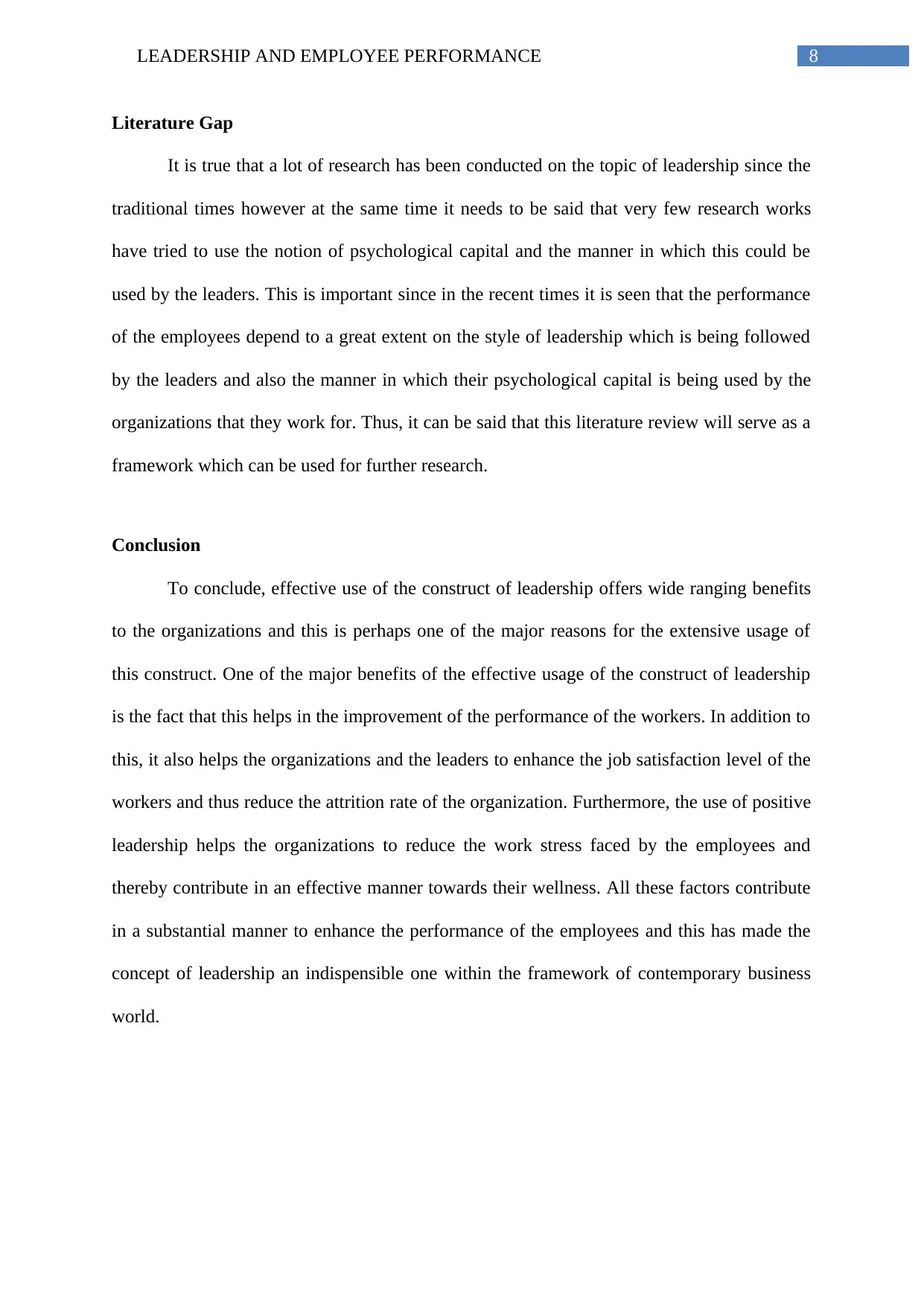
8LEADERSHIP AND EMPLOYEE PERFORMANCE
Literature Gap
It is true that a lot of research has been conducted on the topic of leadership since the
traditional times however at the same time it needs to be said that very few research works
have tried to use the notion of psychological capital and the manner in which this could be
used by the leaders. This is important since in the recent times it is seen that the performance
of the employees depend to a great extent on the style of leadership which is being followed
by the leaders and also the manner in which their psychological capital is being used by the
organizations that they work for. Thus, it can be said that this literature review will serve as a
framework which can be used for further research.
Conclusion
To conclude, effective use of the construct of leadership offers wide ranging benefits
to the organizations and this is perhaps one of the major reasons for the extensive usage of
this construct. One of the major benefits of the effective usage of the construct of leadership
is the fact that this helps in the improvement of the performance of the workers. In addition to
this, it also helps the organizations and the leaders to enhance the job satisfaction level of the
workers and thus reduce the attrition rate of the organization. Furthermore, the use of positive
leadership helps the organizations to reduce the work stress faced by the employees and
thereby contribute in an effective manner towards their wellness. All these factors contribute
in a substantial manner to enhance the performance of the employees and this has made the
concept of leadership an indispensible one within the framework of contemporary business
world.
Literature Gap
It is true that a lot of research has been conducted on the topic of leadership since the
traditional times however at the same time it needs to be said that very few research works
have tried to use the notion of psychological capital and the manner in which this could be
used by the leaders. This is important since in the recent times it is seen that the performance
of the employees depend to a great extent on the style of leadership which is being followed
by the leaders and also the manner in which their psychological capital is being used by the
organizations that they work for. Thus, it can be said that this literature review will serve as a
framework which can be used for further research.
Conclusion
To conclude, effective use of the construct of leadership offers wide ranging benefits
to the organizations and this is perhaps one of the major reasons for the extensive usage of
this construct. One of the major benefits of the effective usage of the construct of leadership
is the fact that this helps in the improvement of the performance of the workers. In addition to
this, it also helps the organizations and the leaders to enhance the job satisfaction level of the
workers and thus reduce the attrition rate of the organization. Furthermore, the use of positive
leadership helps the organizations to reduce the work stress faced by the employees and
thereby contribute in an effective manner towards their wellness. All these factors contribute
in a substantial manner to enhance the performance of the employees and this has made the
concept of leadership an indispensible one within the framework of contemporary business
world.
⊘ This is a preview!⊘
Do you want full access?
Subscribe today to unlock all pages.

Trusted by 1+ million students worldwide
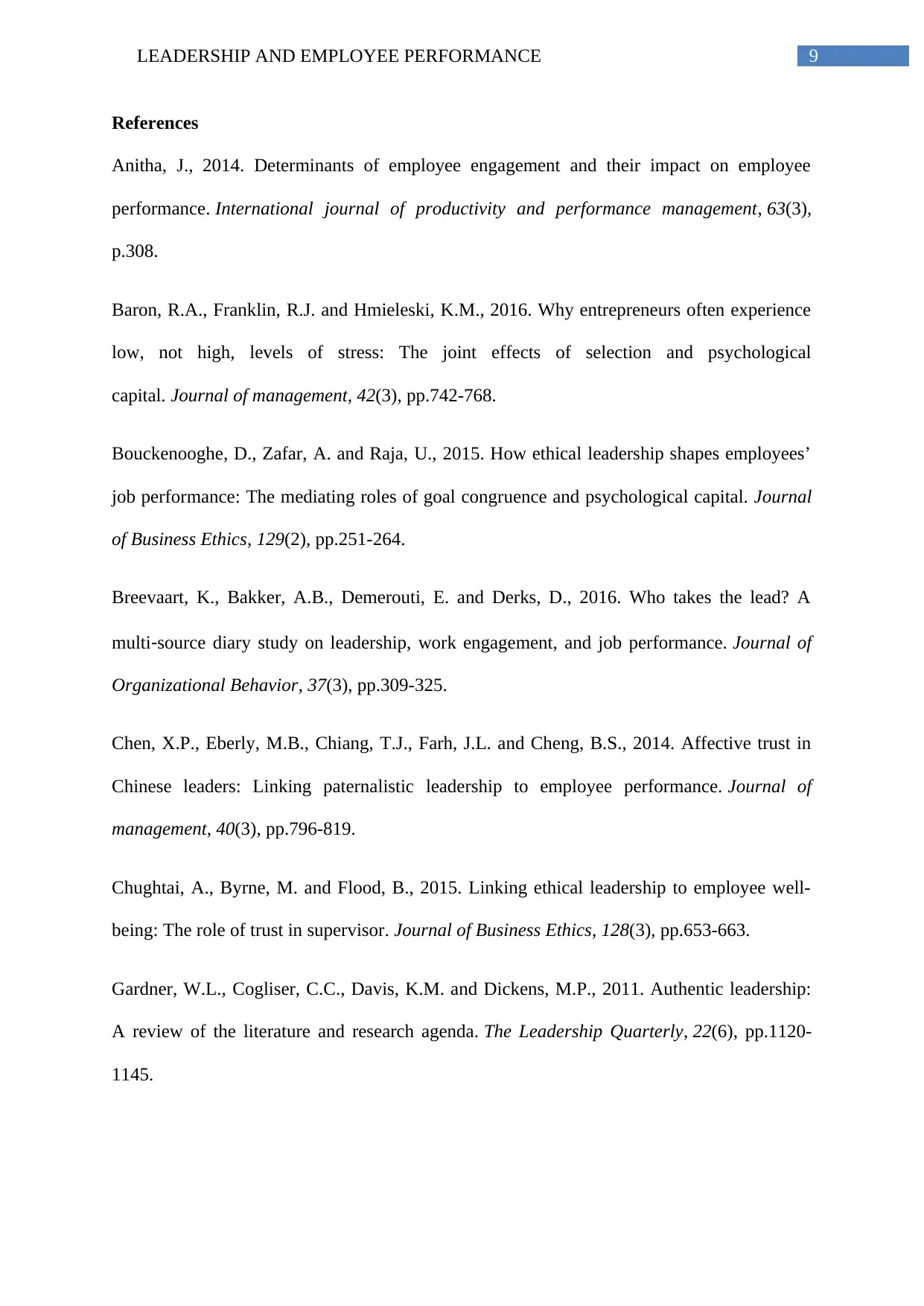
9LEADERSHIP AND EMPLOYEE PERFORMANCE
References
Anitha, J., 2014. Determinants of employee engagement and their impact on employee
performance. International journal of productivity and performance management, 63(3),
p.308.
Baron, R.A., Franklin, R.J. and Hmieleski, K.M., 2016. Why entrepreneurs often experience
low, not high, levels of stress: The joint effects of selection and psychological
capital. Journal of management, 42(3), pp.742-768.
Bouckenooghe, D., Zafar, A. and Raja, U., 2015. How ethical leadership shapes employees’
job performance: The mediating roles of goal congruence and psychological capital. Journal
of Business Ethics, 129(2), pp.251-264.
Breevaart, K., Bakker, A.B., Demerouti, E. and Derks, D., 2016. Who takes the lead? A
multi‐source diary study on leadership, work engagement, and job performance. Journal of
Organizational Behavior, 37(3), pp.309-325.
Chen, X.P., Eberly, M.B., Chiang, T.J., Farh, J.L. and Cheng, B.S., 2014. Affective trust in
Chinese leaders: Linking paternalistic leadership to employee performance. Journal of
management, 40(3), pp.796-819.
Chughtai, A., Byrne, M. and Flood, B., 2015. Linking ethical leadership to employee well-
being: The role of trust in supervisor. Journal of Business Ethics, 128(3), pp.653-663.
Gardner, W.L., Cogliser, C.C., Davis, K.M. and Dickens, M.P., 2011. Authentic leadership:
A review of the literature and research agenda. The Leadership Quarterly, 22(6), pp.1120-
1145.
References
Anitha, J., 2014. Determinants of employee engagement and their impact on employee
performance. International journal of productivity and performance management, 63(3),
p.308.
Baron, R.A., Franklin, R.J. and Hmieleski, K.M., 2016. Why entrepreneurs often experience
low, not high, levels of stress: The joint effects of selection and psychological
capital. Journal of management, 42(3), pp.742-768.
Bouckenooghe, D., Zafar, A. and Raja, U., 2015. How ethical leadership shapes employees’
job performance: The mediating roles of goal congruence and psychological capital. Journal
of Business Ethics, 129(2), pp.251-264.
Breevaart, K., Bakker, A.B., Demerouti, E. and Derks, D., 2016. Who takes the lead? A
multi‐source diary study on leadership, work engagement, and job performance. Journal of
Organizational Behavior, 37(3), pp.309-325.
Chen, X.P., Eberly, M.B., Chiang, T.J., Farh, J.L. and Cheng, B.S., 2014. Affective trust in
Chinese leaders: Linking paternalistic leadership to employee performance. Journal of
management, 40(3), pp.796-819.
Chughtai, A., Byrne, M. and Flood, B., 2015. Linking ethical leadership to employee well-
being: The role of trust in supervisor. Journal of Business Ethics, 128(3), pp.653-663.
Gardner, W.L., Cogliser, C.C., Davis, K.M. and Dickens, M.P., 2011. Authentic leadership:
A review of the literature and research agenda. The Leadership Quarterly, 22(6), pp.1120-
1145.
Paraphrase This Document
Need a fresh take? Get an instant paraphrase of this document with our AI Paraphraser
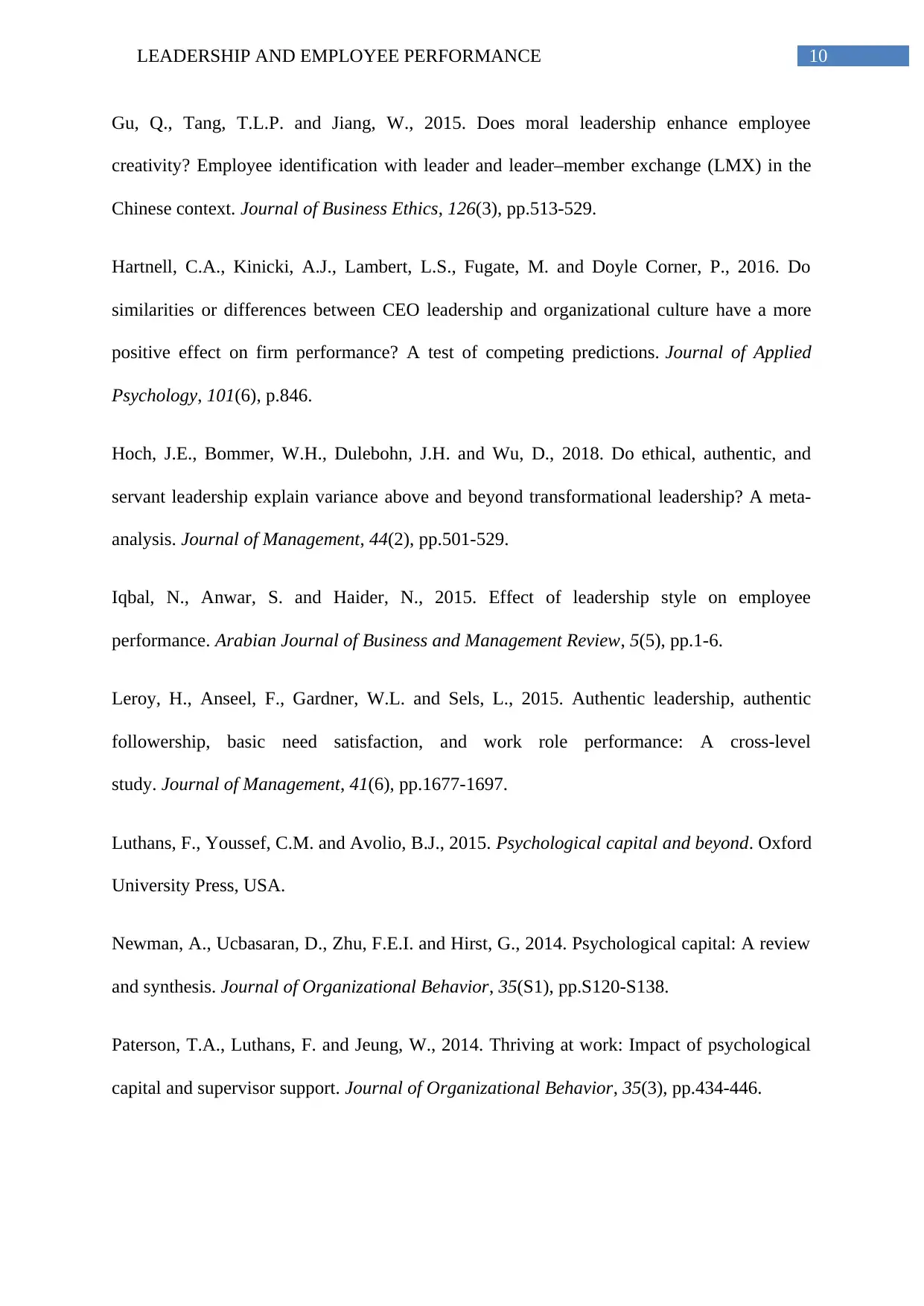
10LEADERSHIP AND EMPLOYEE PERFORMANCE
Gu, Q., Tang, T.L.P. and Jiang, W., 2015. Does moral leadership enhance employee
creativity? Employee identification with leader and leader–member exchange (LMX) in the
Chinese context. Journal of Business Ethics, 126(3), pp.513-529.
Hartnell, C.A., Kinicki, A.J., Lambert, L.S., Fugate, M. and Doyle Corner, P., 2016. Do
similarities or differences between CEO leadership and organizational culture have a more
positive effect on firm performance? A test of competing predictions. Journal of Applied
Psychology, 101(6), p.846.
Hoch, J.E., Bommer, W.H., Dulebohn, J.H. and Wu, D., 2018. Do ethical, authentic, and
servant leadership explain variance above and beyond transformational leadership? A meta-
analysis. Journal of Management, 44(2), pp.501-529.
Iqbal, N., Anwar, S. and Haider, N., 2015. Effect of leadership style on employee
performance. Arabian Journal of Business and Management Review, 5(5), pp.1-6.
Leroy, H., Anseel, F., Gardner, W.L. and Sels, L., 2015. Authentic leadership, authentic
followership, basic need satisfaction, and work role performance: A cross-level
study. Journal of Management, 41(6), pp.1677-1697.
Luthans, F., Youssef, C.M. and Avolio, B.J., 2015. Psychological capital and beyond. Oxford
University Press, USA.
Newman, A., Ucbasaran, D., Zhu, F.E.I. and Hirst, G., 2014. Psychological capital: A review
and synthesis. Journal of Organizational Behavior, 35(S1), pp.S120-S138.
Paterson, T.A., Luthans, F. and Jeung, W., 2014. Thriving at work: Impact of psychological
capital and supervisor support. Journal of Organizational Behavior, 35(3), pp.434-446.
Gu, Q., Tang, T.L.P. and Jiang, W., 2015. Does moral leadership enhance employee
creativity? Employee identification with leader and leader–member exchange (LMX) in the
Chinese context. Journal of Business Ethics, 126(3), pp.513-529.
Hartnell, C.A., Kinicki, A.J., Lambert, L.S., Fugate, M. and Doyle Corner, P., 2016. Do
similarities or differences between CEO leadership and organizational culture have a more
positive effect on firm performance? A test of competing predictions. Journal of Applied
Psychology, 101(6), p.846.
Hoch, J.E., Bommer, W.H., Dulebohn, J.H. and Wu, D., 2018. Do ethical, authentic, and
servant leadership explain variance above and beyond transformational leadership? A meta-
analysis. Journal of Management, 44(2), pp.501-529.
Iqbal, N., Anwar, S. and Haider, N., 2015. Effect of leadership style on employee
performance. Arabian Journal of Business and Management Review, 5(5), pp.1-6.
Leroy, H., Anseel, F., Gardner, W.L. and Sels, L., 2015. Authentic leadership, authentic
followership, basic need satisfaction, and work role performance: A cross-level
study. Journal of Management, 41(6), pp.1677-1697.
Luthans, F., Youssef, C.M. and Avolio, B.J., 2015. Psychological capital and beyond. Oxford
University Press, USA.
Newman, A., Ucbasaran, D., Zhu, F.E.I. and Hirst, G., 2014. Psychological capital: A review
and synthesis. Journal of Organizational Behavior, 35(S1), pp.S120-S138.
Paterson, T.A., Luthans, F. and Jeung, W., 2014. Thriving at work: Impact of psychological
capital and supervisor support. Journal of Organizational Behavior, 35(3), pp.434-446.
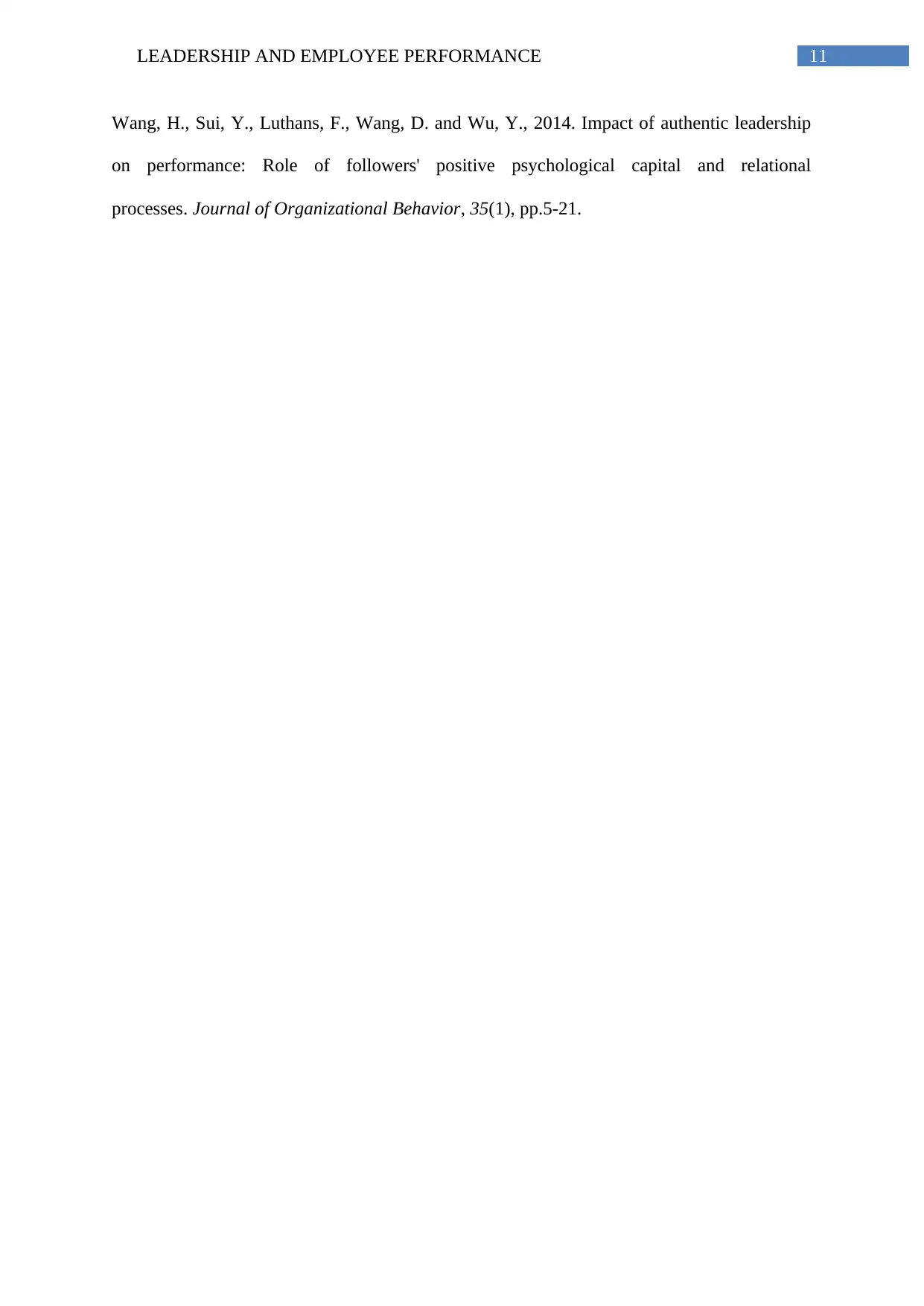
11LEADERSHIP AND EMPLOYEE PERFORMANCE
Wang, H., Sui, Y., Luthans, F., Wang, D. and Wu, Y., 2014. Impact of authentic leadership
on performance: Role of followers' positive psychological capital and relational
processes. Journal of Organizational Behavior, 35(1), pp.5-21.
Wang, H., Sui, Y., Luthans, F., Wang, D. and Wu, Y., 2014. Impact of authentic leadership
on performance: Role of followers' positive psychological capital and relational
processes. Journal of Organizational Behavior, 35(1), pp.5-21.
⊘ This is a preview!⊘
Do you want full access?
Subscribe today to unlock all pages.

Trusted by 1+ million students worldwide
1 out of 12
Related Documents
Your All-in-One AI-Powered Toolkit for Academic Success.
+13062052269
info@desklib.com
Available 24*7 on WhatsApp / Email
![[object Object]](/_next/static/media/star-bottom.7253800d.svg)
Unlock your academic potential
Copyright © 2020–2025 A2Z Services. All Rights Reserved. Developed and managed by ZUCOL.





